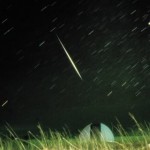Perseids Meteor Shower
August 11, 2013 by staff · Comments Off on Perseids Meteor Shower
Perseids Meteor Shower, A celestial fireworks show peaks Monday and Tuesday as Earth passes though the dust of a comet’s tail.
Humans around the world have witnessed the Perseid meteor shower every August for at least 2,000 years, with dozens of meteors streaking across the sky each hour.
Your view is best after midnight until just before sunrise. Get away from city lights, if possible, for the full effect. A waning crescent moon means less light in the sky to compete with the meteor display. Next year’s show will be dimmed by a full moon.
The annual sky spectacular happens when our planet’s orbit around the sun passes near Comet Swift-Tuttle’s path, which goes by every 130 years. The last close encounter with the comet was 20 years ago, but it left grains of dust in its wake.
The bright streaks you see are “interplanetary dust” burning up as it collides with our atmosphere at about 133,000 mph, according to NASA micrometeoroid expert Diego Janches. “The fragments are either remnants from the solar system’s formation, or they are produced by collisions between asteroids or comets from long ago.”
“Each such fragment is approximately the size of a dime, but the more constant, sporadic meteoroids have been around much longer, breaking down over time into tiny fragments only about as wide as a piece of human hair,” according to NASA.gov.
Geminid Meteor Shower 2010
December 13, 2010 by USA Post · Comments Off on Geminid Meteor Shower 2010
 Geminid Meteor Shower 2010, The constellation of Gemini the Twins is becoming a hot spot of activity for the next two weeks. SkyWatchers see a lot of fire streaks of light from Gemini following Geminids meteor shower annually.
Geminid Meteor Shower 2010, The constellation of Gemini the Twins is becoming a hot spot of activity for the next two weeks. SkyWatchers see a lot of fire streaks of light from Gemini following Geminids meteor shower annually.
Contrary to the shower in August Perseid meteor shower which was held annually for centuries, the Geminid meteor shower is a newcomer.
No one has reported seeing Geminid meteors before 1862, but every December starting this year, the Geminid shower has appeared on the schedule and seems to become stronger and better every year. Astronomers predict that this year’s Geminid meteor shower could be the best, up to 120 meteors per hour at its peak.
The Geminid meteors are unique because the parent body appears to be a rocky asteroid rather than a comet ice. In 1984, astronomers have discovered a small object, about 3 miles in diameter, orbiting in the same way as the swarm of dust that generates our Geminids meteor shower. Now, named Phaeton, this asteroid might be a comet burning in disguise – that is, a comet that has lost all its ice after the passage of many around the sun and is now only the skeleton of a rocky time active comet. The trail of dust that follows Phaethon around the sun could be left over from his day’s comet.
You can start to see some Geminid meteors about a week before the shower peaks on Monday night. A single observer can see dozens of “shooting stars” or meteors per hour near the tip. Meteors fan from a point near the twin stars of Castor and Pollux in the constellation Gemini, but they will be visible in the sky.
Gemini rises above our eastern mountains long before midnight; the action could start earlier than in most meteor showers. And Geminid meteors tend to be slower than the Perseids in August or November Leonids, producing long ridges graceful in the sky. The gibbous moon will be at 1:45 Tuesday morning the peak of the meteor shower, leaving the sky dark and perfect for viewing meteors.
If the sky is clear on Monday night, dress against the cold, relax with a sleeping bag on the floor or in a recliner, and enjoy the fireworks. Remember, the closer on Tuesday at dawn watching the meteors, the more you’re likely to see until the day begins to illuminate the sky. Shower next year’s Geminid meteor shower will be spoiled by a nearly full moon, so you do not want to miss what could be the best meteor shower of 2010.



